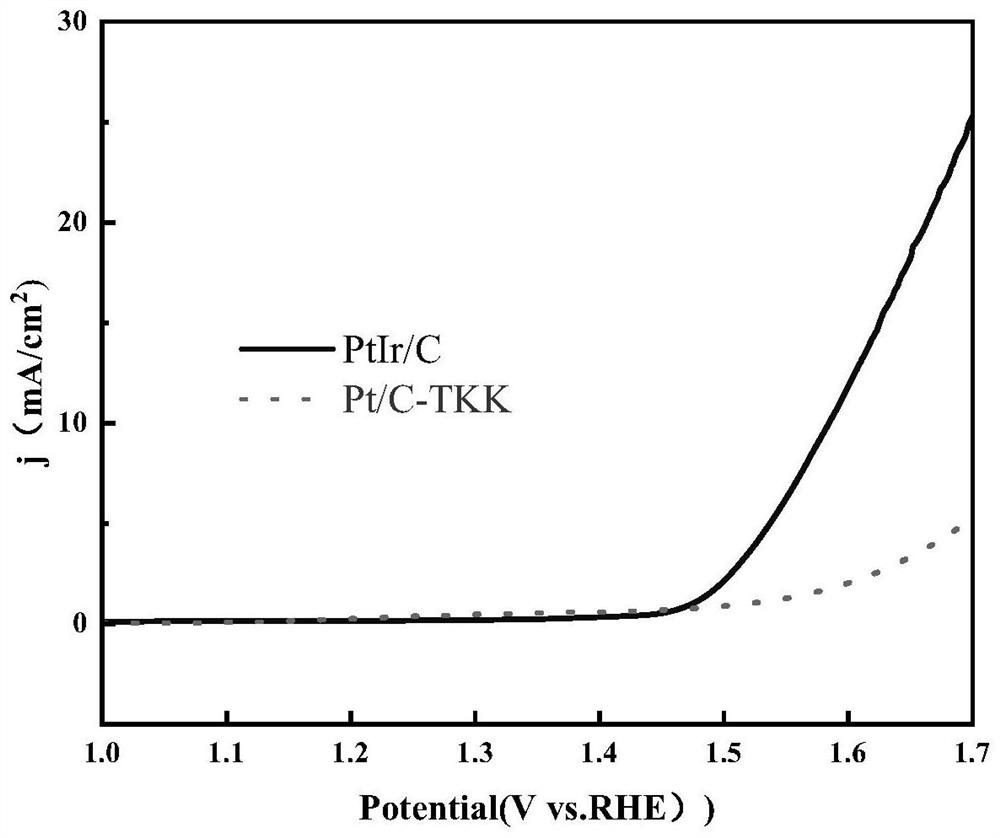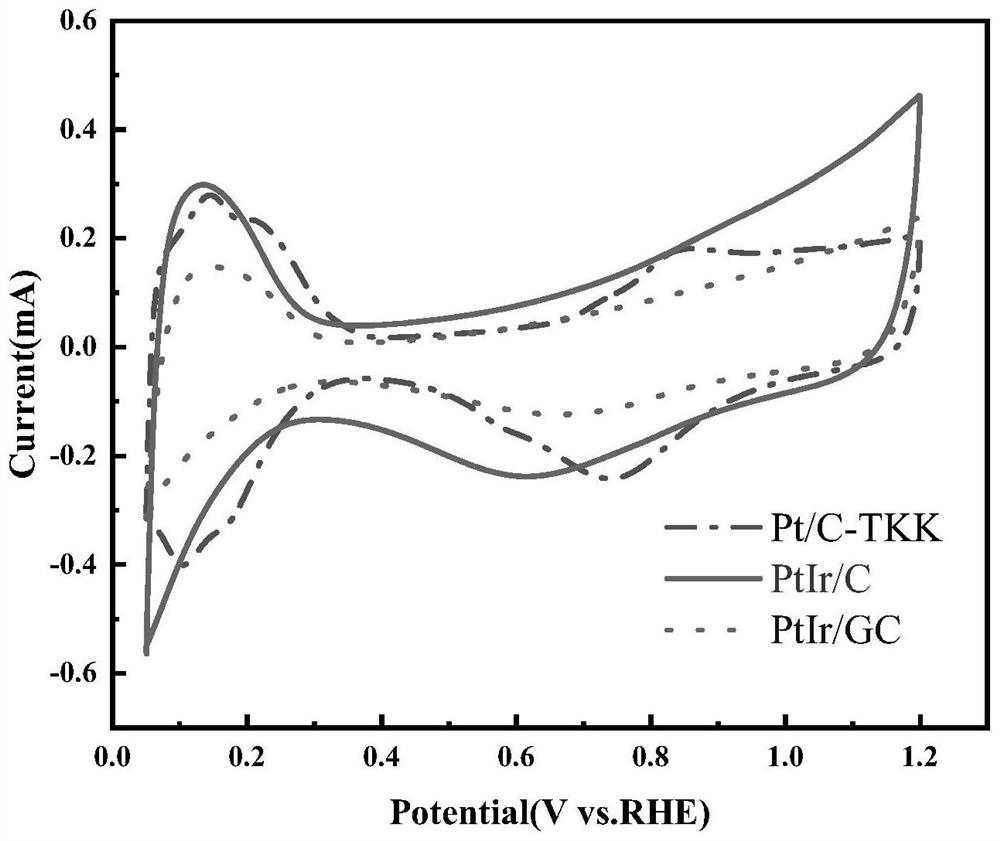Preparation method of antipolar alloy catalyst for fuel cell
An alloy catalyst and fuel cell technology, applied in battery electrodes, circuits, electrical components, etc., can solve the problems of reducing the catalytic effect of platinum on the HOR reaction of batteries, hindering the contact between hydrogen and platinum, and large particle size of iridium oxide. The effect of reverse polarity time, increased difficulty, and simple preparation process
- Summary
- Abstract
- Description
- Claims
- Application Information
AI Technical Summary
Problems solved by technology
Method used
Image
Examples
Embodiment 1
[0038] (1) Weigh 100 mg of chloroplatinic acid and 61.86 mg of iridium chloride into a three-necked flask, add 100 ml of ethylene glycol, stir ultrasonically to dissolve them completely, and adjust the pH of the solution to 11 with 1M sodium hydroxide solution.
[0039](2) Start heating under the protection of nitrogen, heat to a temperature of 140° C., react for 3 hours to obtain a black platinum-iridium colloid, and cool down.
[0040] (3) Select 74.79 mg of VXC72 carbon carrier from Carbot Corporation of the United States to prepare a carbon carrier solution, and the concentration of the carbon carrier solution is 1 mg C / ml (异丙醇) .
[0041] (4) After the platinum-iridium colloid was lowered to room temperature, it was mixed with the VXC72 carbon carrier solution, stirred and ultrasonicated for 2 hours, so that the platinum-iridium alloy was evenly loaded on the carbon carrier, and a PtIr / C solution was obtained.
[0042] (5) Suction filter the above solution, wash with a...
Embodiment 2
[0044] (1) Weigh 100 mg of chloroplatinic acid and 61.86 mg of iridium chloride into a three-necked flask, add 100 ml of ethylene glycol, stir ultrasonically to dissolve them completely, and adjust the pH of the solution to 11 with 1M sodium hydroxide solution.
[0045] (2) Heating was started under the protection of nitrogen, heated to a temperature of 150° C., and reacted for 5 hours to obtain a black platinum-iridium colloid, and the temperature was lowered.
[0046] (3) Put 74.79 mg of Ketjen Black EC300J carbon carrier from Lion King of Japan into a high-temperature tube furnace, perform graphitization treatment at a high temperature of 1600 °C for 3 hours under the protection of nitrogen, and cool down to room temperature for use.
[0047] (4) The carbon carrier after the graphitization treatment is formulated into a carbon carrier solution, and the concentration of the carbon carrier solution is 1 mg C / ml (乙醇+水) .
[0048] (5) After the platinum-iridium colloid is lo...
Embodiment 3
[0051] (1) Weigh 150 mg of chloroplatinic acid and 30.93 mg of iridium chloride into a three-necked flask, add 100 ml of ethylene glycol, stir ultrasonically to dissolve them completely, and adjust the pH of the solution to 12 with 1M sodium hydroxide solution.
[0052] (2) Heating was started under the protection of nitrogen, and the temperature was heated to 160° C., and reacted for 5 hours to obtain black platinum-iridium colloid, and the temperature was lowered.
[0053] (3) Put 299.16 mg of Ketjen Black EC600J carbon carrier from Lion King of Japan into a high-temperature tube furnace, conduct graphitization treatment at 1600°C for 3 hours under nitrogen protection, and cool down to room temperature for use.
[0054] (4) The carbon carrier after the graphitization treatment is formulated into a carbon carrier solution, and the concentration of the carbon carrier solution is 5 mg C / ml (乙醇+异丙醇) .
[0055] (5) After the platinum-iridium colloid was lowered to room tempera...
PUM
| Property | Measurement | Unit |
|---|---|---|
| concentration | aaaaa | aaaaa |
| particle diameter | aaaaa | aaaaa |
| particle diameter | aaaaa | aaaaa |
Abstract
Description
Claims
Application Information
 Login to View More
Login to View More - R&D
- Intellectual Property
- Life Sciences
- Materials
- Tech Scout
- Unparalleled Data Quality
- Higher Quality Content
- 60% Fewer Hallucinations
Browse by: Latest US Patents, China's latest patents, Technical Efficacy Thesaurus, Application Domain, Technology Topic, Popular Technical Reports.
© 2025 PatSnap. All rights reserved.Legal|Privacy policy|Modern Slavery Act Transparency Statement|Sitemap|About US| Contact US: help@patsnap.com



